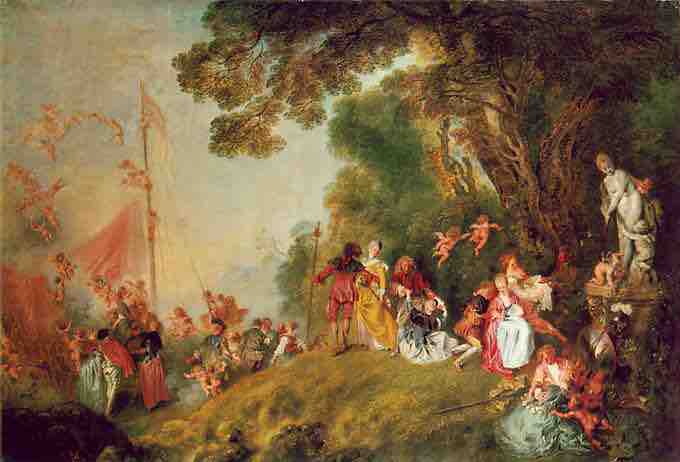Painting during the Rococo period has many of the same qualities as other Rococo art forms such as heavy use of ornament, curved lines and the use of a gold and pastel-based palette. Additionally, forms are often asymmetrical and the themes are playful, even witty, rather than political, as in the case of Baroque art. Themes relating to myths of love as well as portraits and idyllic landscapes typify Rococo Painting.
Antoine Watteau
Antoine Watteau is considered to be the first great Rococo painter. His influence is visible in the work of later Rococo painters such as Francois Boucher and Honore Fragonard. Watteau is known for his soft application of paint, dreamy atmosphere, and depiction of classical themes that often revolve around youth and love, exemplified in the painting ‘Pilgrimage on the Isle of Scythia' .

'Pilgrimage to Cythera' by Antoine Watteau
Watteau's signature soft application of paint, dreamy atmosphere and depiction of classical themes that often revolve around youth and love is evident in his work 'Pilgrimage to Cythera. '
Francois Boucher
Francois Boucher became a master of Rococo painting somewhat later than Watteau. His work exemplifies many of the same characteristics, though with a slightly more mischievous and suggestive tone. Boucher had an illustrious career, and became court painter to King Louis XV in 1765. There was controversy later in his career as Boucher underwent some moral criticism from people such as Diderot for the themes present in his work. 'The Blonde Odalisque' was particularly controversial, as it supposedly illustrated the extra marital affairs of the King .

'Blond Odalisque' by Francois Boucher
'Blond Odalisque' was a highly controversial work by Francois Boucher as it was thought to depict an affair of King Louis XV. The work employs serpentine lines, a reasonably pastel palette and themes of love indicative of Rococo artwork.
Rococo Sculpture
In sculpture, the work of Etienne-Maurice Falconet is widely considered to be the best representative of Rococo style. Generally, Rococo sculpture makes use of very delicate porcelain instead of marble or another heavy medium. Falconet was the director of a famous porcelain factory at Sevres. The prevalent themes in Rococo sculpture echoed those of the other mediums, with the display of classical themes, cherubs, love, playfulness, and nature being depicted most often as exemplified in the sculpture ‘Pygmalion and Galatee' .

'Pygmalion and Galatee' by Etienne-Maurice Falconet
'Pygmalion and Galatee' is indicative of Etienne Maurica Falconet's Rococo style in its depiction of lighthearted love, including a cherub indicating its predisposition to mythology.